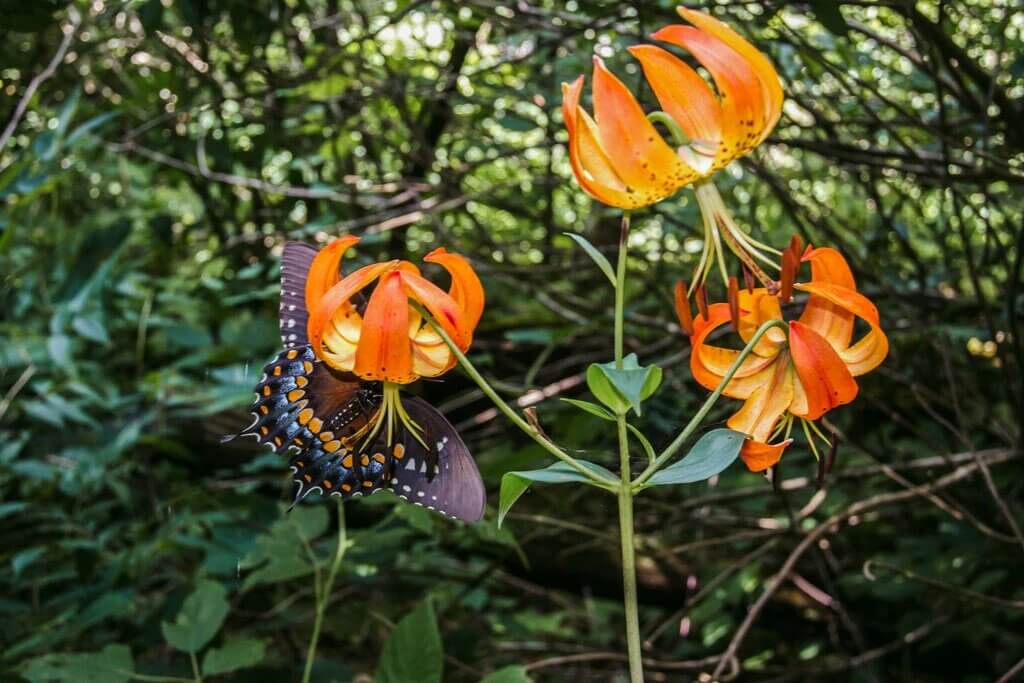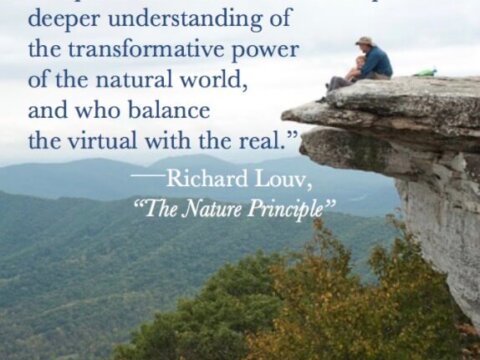OP-ED: FINDING NATURE AND EACH OTHER

A few years ago, Sarah Walker, a college student in Kingston, Ontario at the time, shared with me a benefit of nature connection that I had not considered before.
She described her special place in nature—her “sit spot”—near her home.
“I am sitting on a hill overlooking a wooded forest that defines the landscape of my favorite place in the whole world. I lie with my back against a snowdrift and my snowshoes are strapped to my feet,” Sarah wrote, in a piece for the Children & Nature Network, a nonprofit that works to connect children, families and communities to the natural world. As she gazed up into the cloudless sky, she found herself trying to put a name to what she was feeling. “Today, for the first time, I can tell you with one word … [the reason] I sit outside in this frigid weather: security. As I sit atop this hill, I’m about to finish school in the next couple of months, and I’m not really sure what my next step will be. In spite of this, I know that no matter what life brings my way, I can sit in this spot and watch the sun rise and set below this tree line.”
Security. Before I read Sarah’s piece, I had never particularly connected that word with experiences in the natural world. But there it was, and true.
Today, her statement carries special resonance. How many of us stand at the edge of our yard, or on a balcony, or at the edge of a closed park, and yearn for that sense of security. We can still feel it. The view of a tree line, a distant turning wave, a pigeon on a window ledge, a deer with antenna ears raised toward us, eyes intent, all remind us that we are not alone in the world and that life always finds a way.
The stock market may be rocky, but the value we place on nature, particularly outdoor spaces close to our homes, is surging. So is the research showing the value of a connection with nature to our well-being. In a review of the scientific literature, Ming Kuo, a University of Illinois professor, writes that just seeing nature from a window can “reduce sympathetic nervous activity and increase parasympathetic activity, restore attention and promote healing from surgery.”
In rehabilitative or residential care settings, animals have been shown to calm and comfort people of all ages. Some mental-health practitioners use animals and green environments as part of the therapeutic process. Some pediatricians now prescribe nature.
In the coming months, recognition of nature’s therapeutic value will likely grow, perhaps especially after the pandemic ends and the traumatic effects continue.
When we consider the social capital of a community, why do we include only one species—humans? We are also part of a larger web of nurturing relationships. Research indicates that urban parks with the greatest biodiversity have a higher reported benefit to human psychological health. Studies also suggest that when we interact with companion animals, the neurochemicals and hormones associated with social bonding are elevated. Our positive contact with the wider family of animals may have a similar effect. Nature, as it turns out, can be a civilizing force.
Even before pandemic-induced social distancing, many health care professionals were concerned about an epidemic of loneliness, and that social isolation rivals smoking and obesity as a risk to health. The rise of human loneliness is caused by many factors, but as I suggest in Our Wild Calling, it may also be rooted in species loneliness—a result of our growing nature deficit.
So how, in the time of pandemic and temporarily closed parks and beaches, do we find the nature we need? First by paying attention to the life just outside our windows. Even in the most densely populated neighborhoods, we can notice things about songbirds and raptors and other animals in ways we never knew or took for granted. We can create “sit spots” in our yards, or even next to a window, where we can use all of our senses to quietly immerse ourselves in the life around us. We can send for mail-order seeds to plant a pollinator garden for butterflies. Or, as entomologist Douglas W. Tallamy advises in Nature’s Best Hope, we can help create a homegrown national park by replacing part or all of our lawn with native species. And then watch insects and wildlife that we may have never seen before come home.
This pandemic will either fracture or strengthen our relationships with nature and each other. Surely absence makes the heart grow fonder.
Our post-pandemic challenge will not only be to preserve the last remaining natural places, but to create more of them, especially in cities—and to make sure all children and adults, not just a few, receive the gifts of nature.
As time goes on, we can help create urban wildlife corridors and park expansions. We can support the One Health movement in public health, which recognizes the interconnection of plants, humans, animals and the Earth itself. We can work to reduce global warming and biodiversity collapse, slow the ongoing destruction of natural habitats and build a community of all species.
We can find nature and each other.
In mid-March, sequestered Italians began to sing from their balconies and windows. People in other cities, including Chicago and Dallas, have followed their example. And now that expression of solidarity has come to California.
“In Mill Valley, we have the Mill Valley Howl,” my friend Suz Lipman reported last week, on Facebook. Each night at 8pm, residents open their windows or step outside to howl into the night. “The Howl suits this place, at the edge of the wilderness,” she writes. “From my house, the Howl seems to start low in the valley and swell and run through the neighborhoods and canyons and up into the hills.” A howl is a call of social animals. “Howling lets others know, distinctly, ‘I am here. And I see (and hear) you … we’re here in our houses, we’re here on the planet, we’re with one another, alone and together.’”
So, now and after the virus fades, don’t mourn, plant. Don’t withdraw from the world, persist. And sing the wild calling.
This piece was originally published on the REI blog.
-
Voices
CAMPING WHILE PARENTING: A Mother-Son Adventure
-
Feature
A common thread: Indigenous-led foundation weaves together activism and art, climate and community
-
Network News
Community Spotlight: Prescribe Outside
-
Voices
That’s nice, mija: Finding common language in nature connections
-
Richard Louv
"HUMMINGBIRD PARENTS": Seven Actions Parents Can Take To Reduce Risk And Still Get Their Kids Outside







Commentaries on the C&NN website are offered to share diverse points-of-view from the global children and nature movement and to encourage new thinking and debate. The views and opinions expressed are those of the author(s) and do not necessarily reflect the position of C&NN. C&NN does not officially endorse every statement, report or product mentioned.